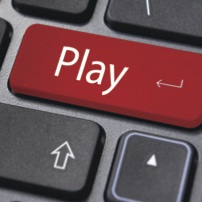
By Nic McMahon
Games are an excellent component of a blended learning program that includes both web and virtual components. According to the Kauffman Foundation, learning by actively engaging in gaming can improve retention by more than 108 percent, making it an attractive learning tool. But how do you enlist an effective gamification program into your business?
The first step to developing a solid, compelling game is to identify the objective. In order to develop the game with intention, start by asking the following questions:
- What do I want learners to remember or walk away with?
- What behavior do I want to change?
- Is a game an appropriate tool to solve the problem and the
- training challenge?
- What type of game is best for this situation?
- How interactive should it be?
- How long should it take to play?
- How many levels and players should it include?
- Will everyone playing the game have access to the same
- technology?
- What are the demographics of the different audiences that
- will be using the game?
- Will it be reusable?
- How will I measure return on investment?
Once these questions have been answered and everyone has a thorough understanding of the objective, the team can scope out the project and build in check points. Part of the learning strategy should also include metrics. A common way to do this is to establish base line knowledge, deploy the game, and then conduct a test after to determine knowledge transfer and retention.
For example, Intel wanted an interactive and engaging game that the more than 70,000 Intel Retail Edge Program could access on their smartphones and tablets to reinforce quarterly sales training on new products. Enter Bot Blast, a story-based game in which the players create an Avatar, then answer a series of questions throughout three levels of play to gain points and defeat the bad guys. The game was designed as a desktop web application, as well as an app, and included a leader board so learners could see how they stacked up against other co-workers. The program was designed to help third-party retailers provide just-in-time information to their sales teams while on the floor. In addition, the game and app development process was established in a way that can be replicated throughout future cycles.
Key Elements
In addition to the multi-sensory video and audio elements of interactive games, there are a few basic components that the brain needs to be able to engage with a game and retain the information being shared. They include:
- Narrative. Stories stick with us. When done correctly, players get engaged with the story and experience an emotional response. This emotional connection to the game helps learners remember the information being taught.
- Challenge. Humans are competitive by nature. We are motivated to win, whether it’s by beating the game or achieving a higher score than our colleagues. But if we’re going to take the risk and put forth effort, there needs to be a reward, even if it’s just a sense of achievement.
- Replayability. The more we repeat something, the more likely we are to remember it. The active learning element of games allows developers to repurpose existing material using new methods and ask questions a few different ways in order to reinforce appropriate behavior.
For example, Autodesk has a very unique culture and diverse audience dispersed across multiple geographies, demographics, and a wide‐variety of roles in the company. As a result, the organization found that the relevant off-the shelf content did not adequately address its compliance needs or engage its employees. Accordingly, the company decided to design a program comprehensive enough to encompass its global competition compliance needs (such as document management and IP protection), while at the same time providing highly interactive and entertaining courses tailored to the specific challenges of the business. It also sought a program that could easily scale the training to add supplementary content and address international audiences. Autodesk opted for an interactive multi-role game to reinforce its overall blended compliance training program by simulating challenges and risk scenarios facing the global organization. The course is based at a virtual conference hosted in Las Vegas where the keynote speaker is an Elvis impersonator with a 1950’s tongue-in-cheek style. In addition, it is translated into several languages.
Traps to Avoid
While building a game can be fun and new, it’s also important to be mindful of how the game will integrate into the overall learning program and be perceived by the audience. Consider these pitfalls before jumping in.
- Don’t overdo it. Respect the audience and their attention span. Don’t try
- to cram in too much information at once.
- Develop for the right platform. Consider how it will look and how learners will interact with the interface.
- Don’t go too far. Watch the tone and make sure it is appropriate for your organization.
Businesses are discovering that games are more than just an entertaining way to pass the time. When used correctly, they can be effective learning tools. In fact, according to Traci Sitzmann, Ph.D, who spent more than a year examining data from more than 6,000 trainees for a University of Colorado Denver study, those using games had an 11 percent increase in factual knowledge, a 14 percent increase in skill-based knowledge, and a 9 percent higher retention rate.
The key is to approach it strategically. Identify the key objectives, determine if a game is the right tool to accomplish these goals, and repurpose the game for future learning programs.

An important consideration to adopting an e-learning gaming strategy is if you build a smart game infrastructure it can be cost effective and easily repurposed repeatedly across the enterprise. As long as the gaming mechanics are solid, the game can be simply re-skinned with appropriate graphics and relevant content for different departmental goals. This provides the opportunity for all areas of the company to leverage the game for their unique needs with less risk.
For example HP created three game- based learning tools—Olympics, Dwarf Planet, and Storm Chasers— that are scalable and reusable, so they can be repurposed by multiple departments and rolled out globally. Because of the low cost of the revisions, game development is now an option available to all learning program managers within HP. They can quickly add one or two games to augment their individual learning programs with a cost below 20 percent of developing the game from scratch. In 2012, more than 2,700 HP employees played learning games in the sales fitness center.
In 2013, 49 learning program managers — representing approximately one-third of the HP learning organization — attended a live webinar featuring the game templates. After the webinar, 12 additional learning program managers representing different departments across HP implemented the templates to create games as additions to their own curricula.














